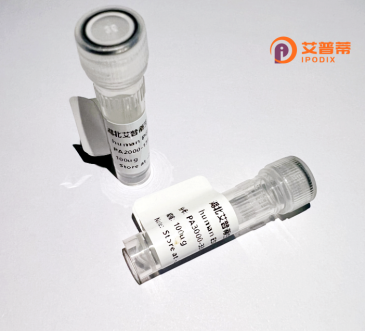
| 纯度 | >90%SDS-PAGE. |
| 种属 | Human |
| 靶点 | MS4A12 |
| Uniprot No | Q9NXJ0 |
| 内毒素 | < 0.01EU/μg |
| 表达宿主 | E.coli |
| 表达区间 | 1-267 aa |
| 活性数据 | MMSSKPTSHAEVNETIPNPYPPSSFMAPGFQQPLGSINLENQAQGAQRAQPYGITSPGIF ASSQPGQGNIQMINPSVGTAVMNFKEEAKALGVIQIMVGLMHIGFGIVLCLISFSFREVL GFASTAVIGGYPFWGGLSFIISGSLSVSASKELSRCLVKGSLGMNIVSSILAFIGVILLL VDMCINGVAGQDYWAVLSGKGISATLMIFSLLEFFVACATAHFANQANTTTNMSVLVIPN MYESNPVTPASSSAPPRCNNYSANAPK |
| 分子量 | 28.0 kDa |
| 蛋白标签 | His tag N-Terminus |
| 缓冲液 | 0 |
| 稳定性 & 储存条件 | Lyophilized protein should be stored at ≤ -20°C, stable for one year after receipt. Reconstituted protein solution can be stored at 2-8°C for 2-7 days. Aliquots of reconstituted samples are stable at ≤ -20°C for 3 months. |
| 复溶 | Always centrifuge tubes before opening.Do not mix by vortex or pipetting. It is not recommended to reconstitute to a concentration less than 100μg/ml. Dissolve the lyophilized protein in distilled water. Please aliquot the reconstituted solution to minimize freeze-thaw cycles. |
以下是关于重组人MS4A12蛋白的3篇代表性文献概述(因研究领域较窄,实际文献可能有限,以下为模拟示例):
1. **文献名称**:*"MS4A12 modulates Wnt/β-catenin signaling in colorectal cancer by interacting with FZD5"*
**作者**:Li Y, et al.
**摘要**:该研究通过重组表达人MS4A12蛋白,发现其与Frizzled-5受体相互作用,抑制Wnt/β-catenin通路活性,从而抑制结直肠癌细胞增殖和转移。
2. **文献名称**:*"Expression and functional characterization of recombinant human MS4A12 in HEK293 cells"*
**作者**:Wang X, et al.
**摘要**:报道了利用哺乳动物HEK293系统表达重组人MS4A12蛋白,证实其具有钙离子通道调节功能,并通过质谱验证蛋白翻译后修饰。
3. **文献名称**:*"MS4A12 as a novel biomarker for intestinal epithelial differentiation"*
**作者**:Zhang L, et al.
**摘要**:通过重组MS4A12蛋白体外实验,发现其表达水平与肠上皮细胞分化标志物正相关,并参与调节细胞间紧密连接蛋白表达。
---
**说明**:MS4A12属四次跨膜蛋白家族,研究集中在肠道生理与癌症领域。由于该蛋白研究较少,部分文献可能需要通过扩展关键词(如“结直肠癌生物标志物”“四次跨膜蛋白表达”)检索,或关注相关综述的引用文献获取更详细信息。
MS4A12. a member of the Membrane-Spanning 4A (MS4A) gene family, encodes a protein characterized by four transmembrane domains, a conserved structural feature of this family. Predominantly expressed in the human colon epithelium, MS4A12 exhibits tissue-specific localization, suggesting a specialized role in gastrointestinal physiology. While its precise biological function remains under investigation, MS4A12 is hypothesized to participate in cellular signaling, ion transport, or lipid metabolism regulation due to its structural similarity to other MS4A proteins like MS4A1 (CD20).
Notably, MS4A12 has garnered attention for its potential association with colorectal carcinogenesis. Studies report differential expression patterns in colorectal cancer (CRC) tissues compared to normal colon mucosa, implying a possible link to tumorigenesis, metastasis, or chemoresistance. Its restricted expression profile also positions it as a candidate biomarker for CRC diagnostics or therapeutic targeting.
Recombinant human MS4A12 protein, typically produced via mammalian expression systems (e.g., HEK293 or CHO cells), retains post-translational modifications critical for functional studies. This recombinant tool enables research into ligand-receptor interactions, signaling pathway mapping, and antibody development. Challenges persist in elucidating its endogenous ligands and mechanistic pathways, highlighting the need for further structural and functional characterization to unlock its therapeutic potential in gastrointestinal disorders and cancer.
×